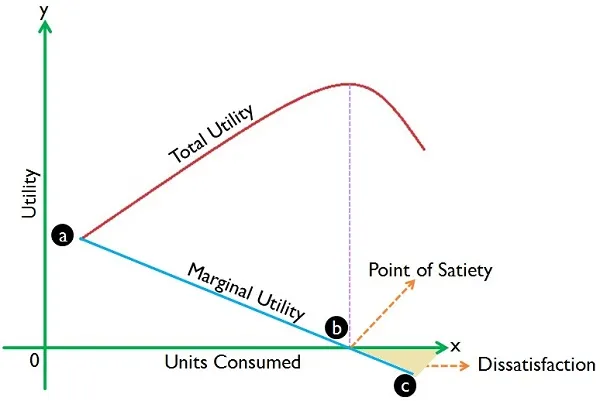||

Have you ever wondered how buffets make money if they allow people to eat endless amounts of food for a set price? Or why things like pain killers are less and less effective the more you use them? Along with underlying principles of psychology and anatomy, both of these examples can be modeled by the simplified economic model of diminishing marginal utility (DMU).
We turn to the simplified models and functions of economics to explain the relationship between humans and scarce resources. Through the use of simplified models and functions, economics models human behavior by assuming it is perfectly rational. When looking at rational human behavior, we assume consumers will only spend money in a way that will maximize their satisfaction and the highest amount of personal utility. Essentially, we assume every human rationally weighs risk and reward with every decision they make. Various economic laws and concepts can be displayed using different models and functions, whether it is graphically, mathematically, or intuitively. In this article, we will be taking a closer look at the law of diminishing marginal utility with a graphical, mathematical, and intuitive approach.
When looking at the concept of diminishing marginal utility, we first need to understand what a utility function is. A utility function is a tool in economics used to relate preference for multiple goods and services. Utility is a term economists like to use to quantify the amount of satisfaction a consumer receives after using or purchasing a product. Marginal utility refers to the increase in utility a consumer experiences after consuming one additional unit, hence the term marginal. For those who have taken calculus, marginal utility is the derivative of the utility function with respect to one element.
The law of diminishing marginal utility, also sometimes referred to as Gossen’s First Law, simply states that as a consumer consumes more, the marginal utility decreases. In other words, as consumption of goods or services increases, satisfaction gradually increases at a decreasing rate. For example, on a hot summer day, a glass of water provides a high amount of satisfaction by quenching your thirst. You may still be slightly thirsty after that first glass, so the second glass of water you drink will still provide you satisfaction, but it won’t yield as much satisfaction as the first glass provided. In other words, your happiness increases with every glass of water you drink, but the rate at which your happiness increases with each glass of water decreases.

The graph above shows us the key points of a utility graph which showcases the concept of diminishing marginal utility. First, we see that total utility continues to increase while the marginal utility is positive. However, when the marginal utility is negative, an additional unit will actually lead to decreased total satisfaction. The positive area between marginal utility and the x-axis shows us the quantitative amount of satisfaction from each additional unit. On the other hand, the negative area between marginal utility and the x-axis shows us the quantitative amount of dissatisfaction from each additional unit.
It is important to understand that at a point, more units of a good will actually lead to dissatisfaction. For example, at a buffet when you first start to eat, you begin feeling satisfied. However, at a point when you are already full, if you continue to consume more units of food, you will eventually just start to feel sick. Similarly, on our hot summer day you can keep drinking glasses of water and receiving more satisfaction till the point of satiety, which is labeled on the graph above. After that point, drinking more water will actually make you feel dissatisfied. Quantitatively, that means your marginal utility will turn negative and your total utility will begin decreasing after that point. The point of satiety is where the total utility is maximized because up till that point, the marginal utility was always positive.
Economics is based on asking how much you want the next unit (the marginal approach) instead of asking how many elements you want total. This is because it is easier to make the isolated decision of “do you want the next glass of water?” rather than make the decision of “how many glasses of water do you want?” For this reason, we analyze marginal utility as well as total utility.
Now that we know of the concept of diminishing marginal utility, we can apply it to real life examples. Have you ever gone to Starbucks and wondered, why am I able to buy a cup of coffee that is twice as large, for much less than twice as much money? Stores often price different sizes in such a way because of diminishing marginal utility! Stores know that because you have more product available to you when you get a larger size, as you consume more of it, you want the additional product less and less. Stores increase prices for different sizes at a decreasing rate to reflect that. For example, that first sip of coffee sounds the most refreshing but after you’ve had a full cup, you may not want coffee as much. Even if you are someone who would like twice as much coffee, the utility function shows us that a rational consumer would decide that twice as much coffee is not worth twice the price, because it won’t give them twice the satisfaction. It will, however, give you more satisfaction until the point of satiety, which is why the consumer will be willing to pay more for double the coffee, just not double the price. Because they are willing to pay more, the price for a large cup of coffee is higher than the price for a small cup of coffee, but not at the same rate at which the amount of product increases.
Of course, as there are with most economic principles, there are exceptions to the law of diminishing marginal utility. One example of an exception that economists have studied in relation to diminishing marginal utility is addictive substances. This is because as you consume more of the substance, your want for the substance increases. However, for the most part, the principle of diminishing marginal utility effectively models rational human behavior, where additional amounts of product provide satisfaction to the consumer at a decreasing rate.
||
---------------------------
By: Ishita Birmani
Title: Intro to Diminishing Marginal Utility
Sourced From: streetfins.com/intro-to-diminishing-marginal-utility/
Published Date: Wed, 15 Jun 2022 04:28:02 +0000
Read More
Did you miss our previous article...
https://peaceofmindinvesting.com/clubs/what-is-halal-investing
.png) InvestingStocksToolsClubsVideosPrivacy PolicyTerms And Conditions
InvestingStocksToolsClubsVideosPrivacy PolicyTerms And Conditions
